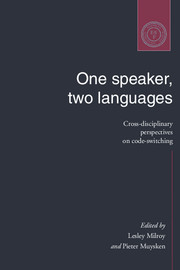Book contents
- Frontmatter
- Contents
- Notes on contributors
- Acknowledgments
- 1 Introduction: code-switching and bilingualism research
- Part one Code-switching in institutional and community settings
- Part two Code-switching and social life
- Part three Grammatical constraints on code-switching
- 9 Code-switching and grammatical theory
- 10 Patterns of language mixture: nominal structure in Wolof-French and Fongbe-French bilingual discourse
- 11 A lexically based model of code-switching
- Part four Code-switching in bilingual development and processing
- Index
11 - A lexically based model of code-switching
Published online by Cambridge University Press: 05 June 2012
- Frontmatter
- Contents
- Notes on contributors
- Acknowledgments
- 1 Introduction: code-switching and bilingualism research
- Part one Code-switching in institutional and community settings
- Part two Code-switching and social life
- Part three Grammatical constraints on code-switching
- 9 Code-switching and grammatical theory
- 10 Patterns of language mixture: nominal structure in Wolof-French and Fongbe-French bilingual discourse
- 11 A lexically based model of code-switching
- Part four Code-switching in bilingual development and processing
- Index
Summary
Introduction
Although the first students of code-switching (CS) focussed on its social functions and were largely sociolinguists, soon a structural question – where in a sentence might a speaker switch from one linguistic variety to another – caught the attention of more researchers. These now included not only sociolinguists, but also syntacticians and psycholinguists. The first of these looked to the surface structure of sentences for clues about constraints on switching. For example, many concentrated on the extent to which like constituents matched in word order across the languages involved in CS (e.g. Lipski 1977; Pfaff 1979; Poplack 1981; Sridhar and Sridhar 1980). Others pointed to surface category memberships, arguing that switches were not possible involving certain categories, such as pronominal clitics (Timm 1975) or any bound morphemes (Poplack 1981). Still others suggested that the size of the constituent had something to do with its switchability (e.g. Gumperz 1982). The common feature of such structural constraints was that while they described CS phenomena in a specific data set, they had no independent motivation relating them to other findings or to theories about the nature of linguistic structures. Possibly for this reason, when subsequent researchers examined other data, they found many counterexamples to the earlier claims (e.g. Bokamba 1988; Romaine 1989).
This emphasis on only descriptive adequacy changed in the mid-1980s as some researchers sought explanations for CS configurations within current syntactic or psycholinguistic theories.
- Type
- Chapter
- Information
- One Speaker, Two LanguagesCross-Disciplinary Perspectives on Code-Switching, pp. 233 - 256Publisher: Cambridge University PressPrint publication year: 1995
- 27
- Cited by

